The world record price for a car at auction was smashed this month when Juan Manuel Fangio's 1954 Mercedes W196 F1 Silver Arrow sold for US$31 million, roughly doubling the previous auction record.
The hammer fell at £17.5 million during the Goodwood Festival of Speed Sale conducted by British auction house Bonhams on 12 July, with an unidentified telephone bidder effectively paying £19,601,500 (about US$29.633 million with commissions and premiums), it eclipsing the previous record price for an auction car of £10,086,400 set by the Ferrari Testa Rossa prototype in 2011 (image below).
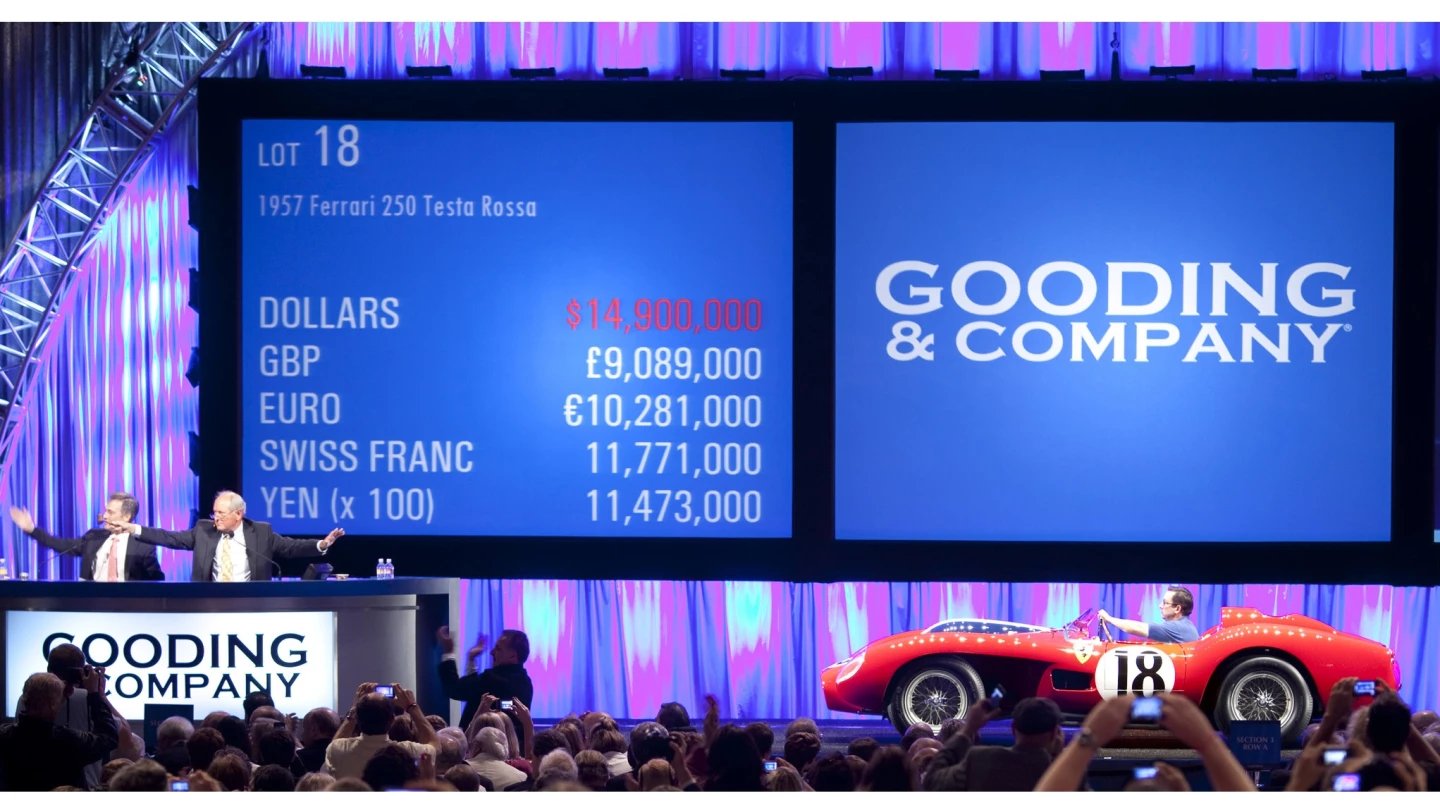
That's an extraordinary amount of money. After 100 years of automotive investing, the highest price ever achieved at auction doubled.
Just how can a car be worth that much? It is one of those vehicles which satisfies every facet of automotive investing: rare, world-changing, beautiful, laden with technological firsts and highly successful, having been driven to famous victories by one of history's most charismatic characters.

Rarity. Tick. Prior to its current tilt at Formula One, Mercedes-Benz had only competed at the highest level of motorsport once in the post-WWII era after a 15 year absence. The company returned to racing in 1954 with the stated intention of winning both the World F1 title and the World Sportscar championship, achieved everything it set out to do inside two years, then shut it all down. That's an image of the final announcement and symbolic covering of the vehicles below. The four corners of the cover are held by Stirling Moss, Race Chief Alfred Neubauer, Karl Kling and Juan Manuel Fangio.
Only fourteen W196R machines ever existed. Ten still exist, three are in museums and six inside Mercedes-Benz. That leaves the recently auctioned Silver Arrow W196R chassis 006/54. It is the ONLY post-war Mercedes-Benz Silver Arrow in private hands.
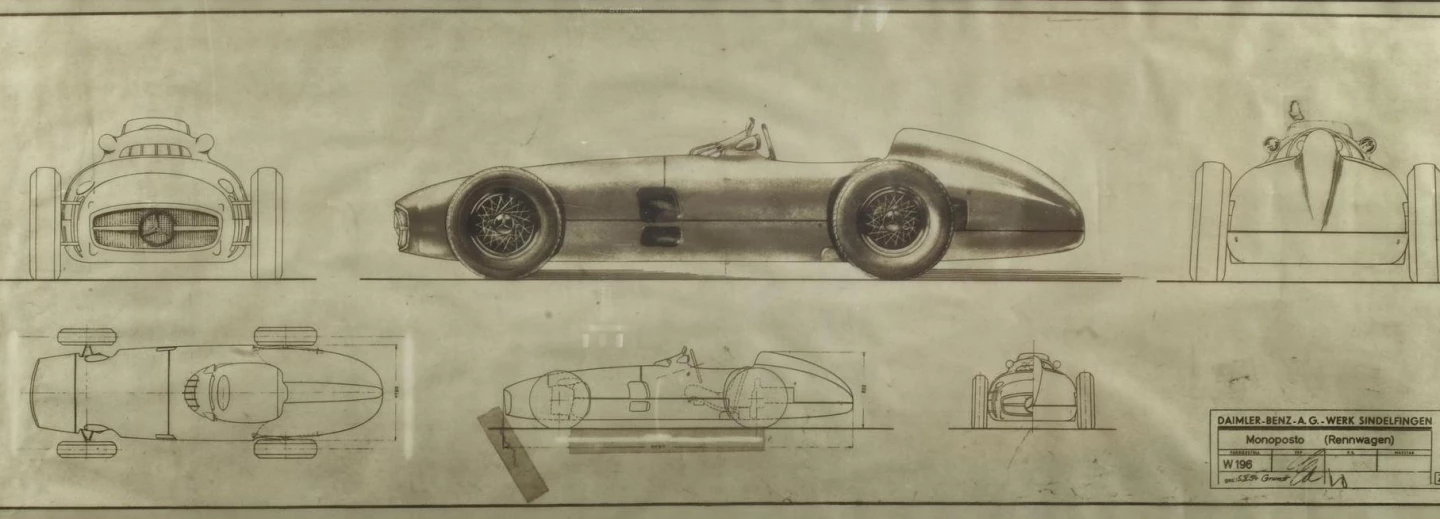
A technological gem
The Silver Arrow was driven by the most respected driver of all-time, Juan Manuel Fangio, to famous back-to-back victories that sealed his 1954 Formula One driver's title. More on Fangio later in the article.Most of all, it is aptly described by the Bonhams catalogue as "supreme mechanical artistry."
It is a technological gem. It was built specifically to win a world title and it effectively won two inside 18 months with a final scorecard showing 12 starts, nine wins.
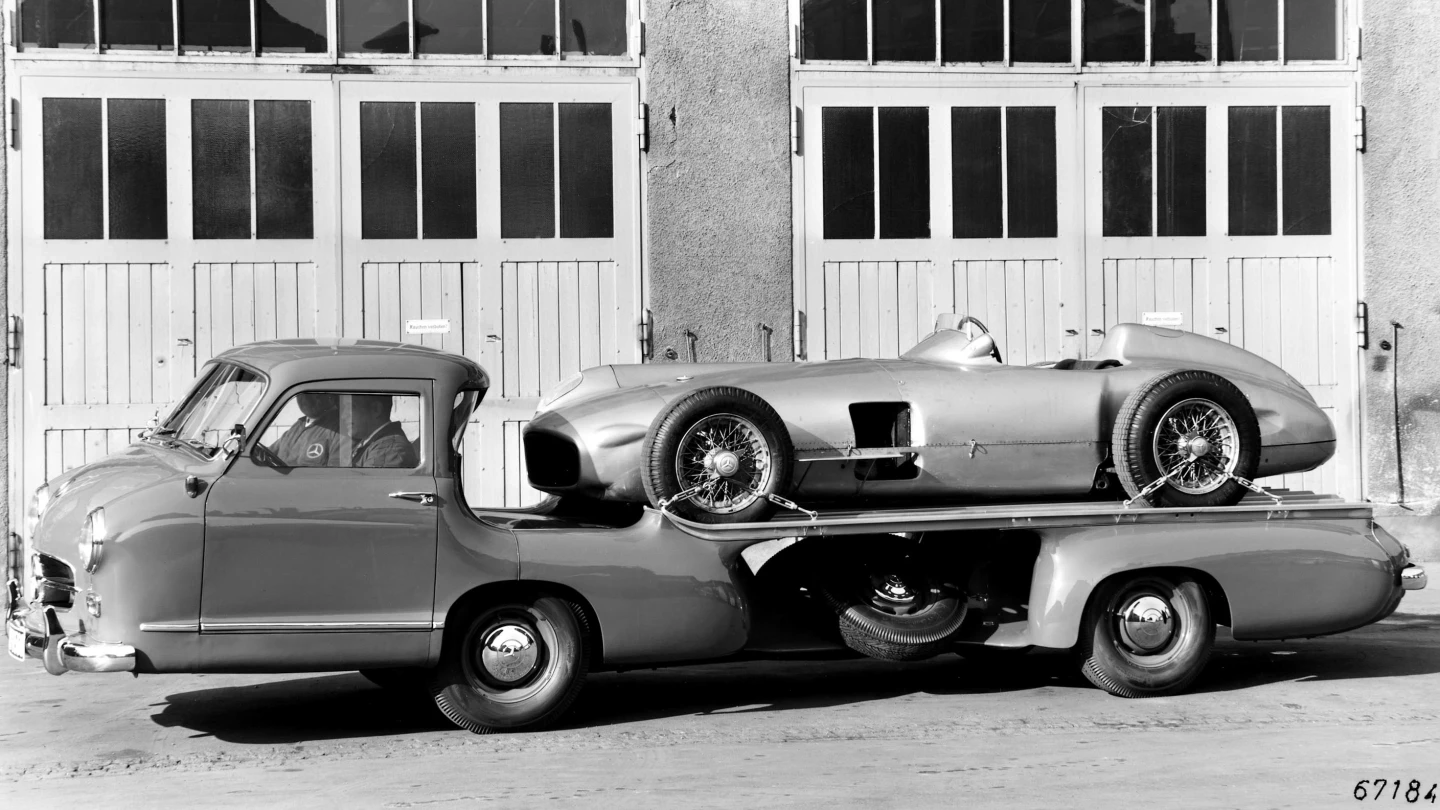
The W196R was the first first fuel-injected F1 car. Mercedes Benz closely collaborated with German company Bosch to deliver this innovation which quickly became a standard feature on every F1 car.

Its lightweight space frame weighed just 36 kg (73 lb). A very similar space frame was used in the W125 Silver Arrow of 1937, which produced 595 bhp and had an overall weight of just 750 kg (1653 lb), a power-to-weight ratio that wasn't bettered until the turbo cars of the eighties.
Mercedes designer Rudolf Uhlenhaut had been responsible for the design of the W125 racing car of 1937, the W154 of 1938, W165 of 1939, and when he began working again on the successor (the W196R) after the war, similar design principles were used.
Uhlenhaut was appointed head of the Mercedes Benz passenger car test department in 1949 and the resultant family of F1, Sportscars and SL designated road cars cars including the W194 and W198. Uhlenhaut took the concept to the next level with the W196R, and he is seen here with the most famous use of the concept, the 1955 300 SLR Mercedes sports car (also known as W196S), displaying the same laid-down straight motor (in this case a six-cylinder) designed to offer the lowest possible frontal area.

A myriad of other technological firsts on the W165R ensures it is one of the milestone vehicles in racing history, a car that demonstrates significant thought leadership on many levels. Desmodromic valve actuation (as used by Ducati sixty years later), inboard brakes, independent suspension and an aerodynamics package so far ahead of the game that it put the team in a different league.
The desmosdromic valve actuation used on the straight eight wasn't technically the first time the technology had appeared in Formula One (the 1914 Grand Prix Delage and Nagant used a different type of desmodromic valve system), but it was the first that worked and Ducati and Mercedes-Benz are still the only makers to produce world championship winning perfomance using desmodromic valve actuation. Interestingly, Ducati's use of desmodromic valve actuation began in the period immediately following the success of the W196R and W196S. Fabio Taglioni's desmodromic valve system for the Ducati 125 Grand Prix was developed in 1956.
Mercedes-Benz was the first manufacturer to successfully overcome the limitations of the simple spring in closing valves. These days, computer-controlled pneumatic valve actuation is standard in Formula One and at the competitive end of the MotoGP field, having first been introduced by Renault in the eighties for its high-speed turbo-charged engines. Renault is currently researching electromagnetic valve actuation.

World leading aerodynamics
During the late 1930s, Mercedes Benz was unquestionably at the forefront of understanding in automotive aerodynamics, with numerous speed attempts and the construction of the first full scale automotive wind tunnel at Untertürkheim in 1939.
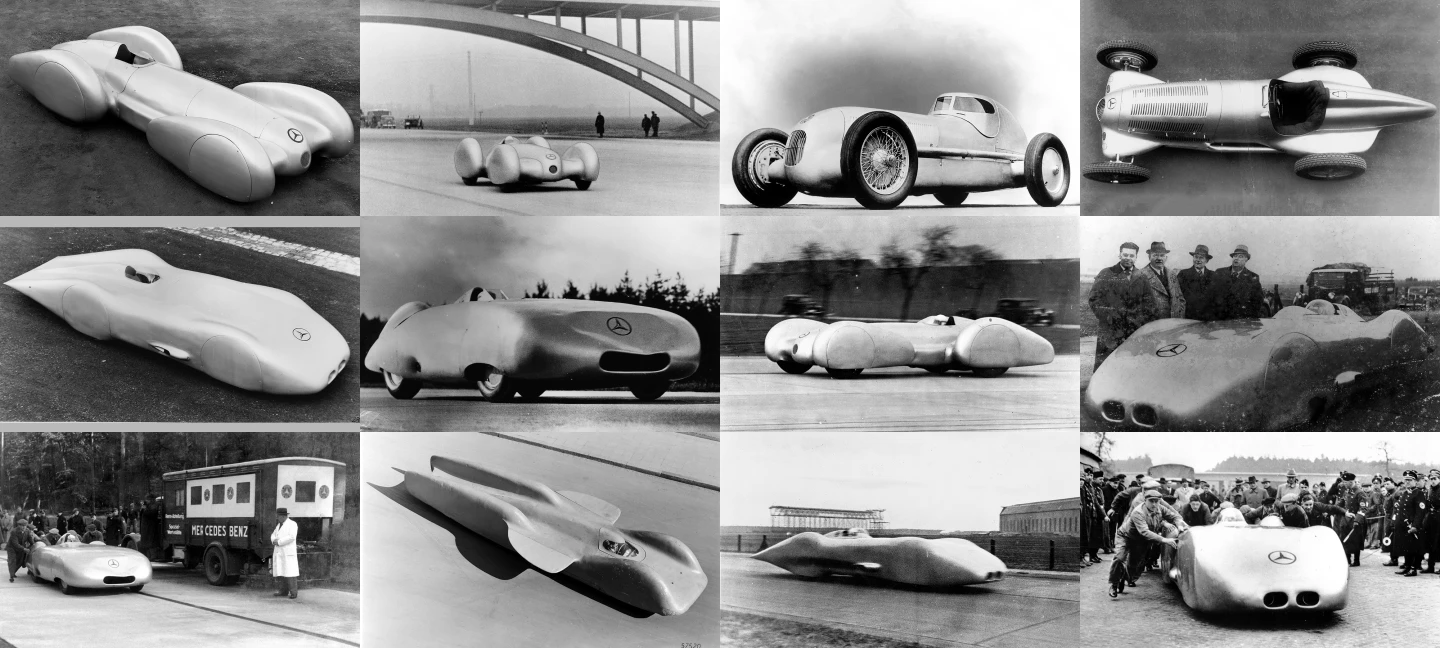
The above photo compilation shows at least ten different Mercedes-Benz aerodynamic and speed projects, all from the era prior to WWII.
In this period, Mercedes-Benz streamliners began aiming for the land speed record and the fastest attempt, based on a twin-supercharged W125 Grand Prix car producing 736 horsepower, achieved 432.7 km/h (269 mph) over the flying kilometer on January 28, 1938 ON PUBLIC ROADS! This speed is claimed by Mercedes-Benz to be the fastest ever officially timed speed on a public road to this day.
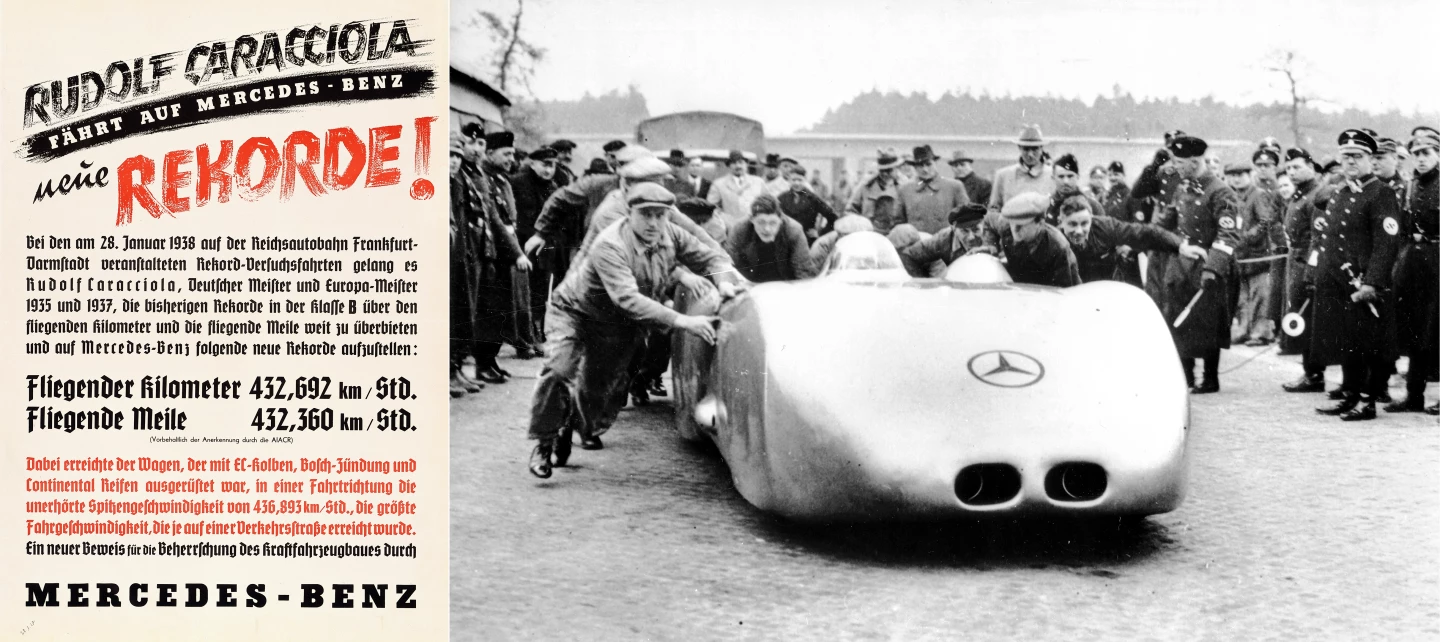
Before the "space race" became a metaphor for national technological capability, the Grand Prix motor race was regarded, at least by Hitler and Mussolini, as the most readily available way of displaying a country's world-leading technological prowess.
The Mercedes-Benz T80 is a record-attempt machine which history denied the opportunity to run. Championed by well-connected Mercedes race driver Hans Stuck, the Mercedes-Benz T80 record machine was nicknamed the "Schwarzer Vogel" (Black Bird) by the Fuhrer, Adolf Hitler, a swipe at the Bluebird, the car of land speed record holder Donald Campbell of Great Britain.
Campbell's cars were all named Bluebird, from the 1931 car which gave him the world record at 246.09 mph (396.03 km/h) in 1931, through four successful subsequent attempts culminating in Campbell's 301.13 mph (484.60 km/h) in 1937.
In 1930s Europe, the exploits of Mercedes Benz and Auto Union for Germany, and Alfa Romeo and Maserati for Italy, were powerful tools key to the national interests of their home countries.

The streamlined T80 Blackbird was scheduled to attempt the world land speed record in January 1940, running a 3000 bhp V12 engine lifted from a Messerschmitt Bf 109 fighter plane.
The lengths to which the Mercedes factory pushed technology in its attempts was astonishing for the period. The V12 was burning a mixture of methyl alcohol (63%), benzene (16%), ethanol (12%), acetone (4.4%), nitrobenzene (2.2%), avgas (2%), and ether (0.4%) with methanol-water injection to cool the charge and boost pressure. The T80 was complete and readying for the record when WWII began, and the run was never attempted. The car can now be seen at the Mercedes-Benz World museum in Stuttgart.
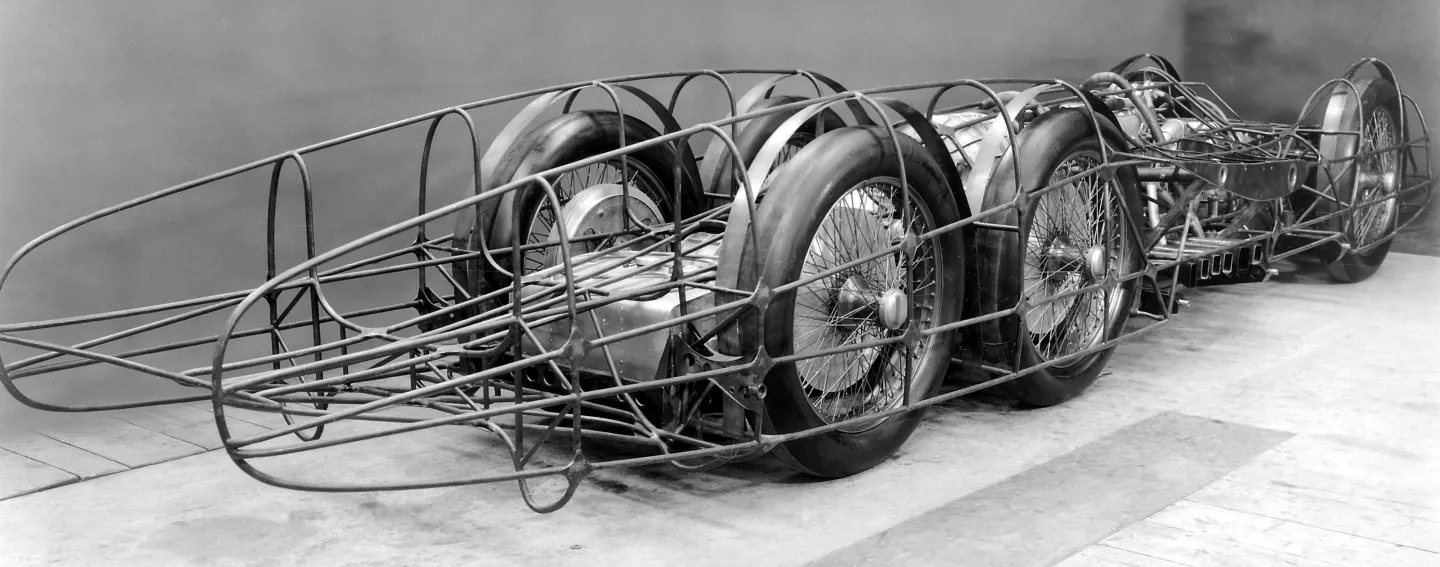
With an windtunnel-shaped body and 3000 horsepower, the Blackbird targeted a top speed of 750 km/h (466 mph). By that stage, the world land speed record was 595 km/h (369.74 mph) set by American John Cobb in his Railton Special on August 23, 1939, and was to stand for another eight years thanks to the outbreak of WWII just one week after the record run.
The land speed record attempt with Hans Stuck at the wheel was set for January 1940. Had the Blackbird gone anywhere near its targeted top speed, it might be far more than a footnote in history. The world "wheel-driven" land speed record set in 1964 by Malcolm Campbell's son Donald (in another car named Bluebird), was 403.10 mph (644.96 km/h) – still 100 km/h short of Mercedes' target in 1940.
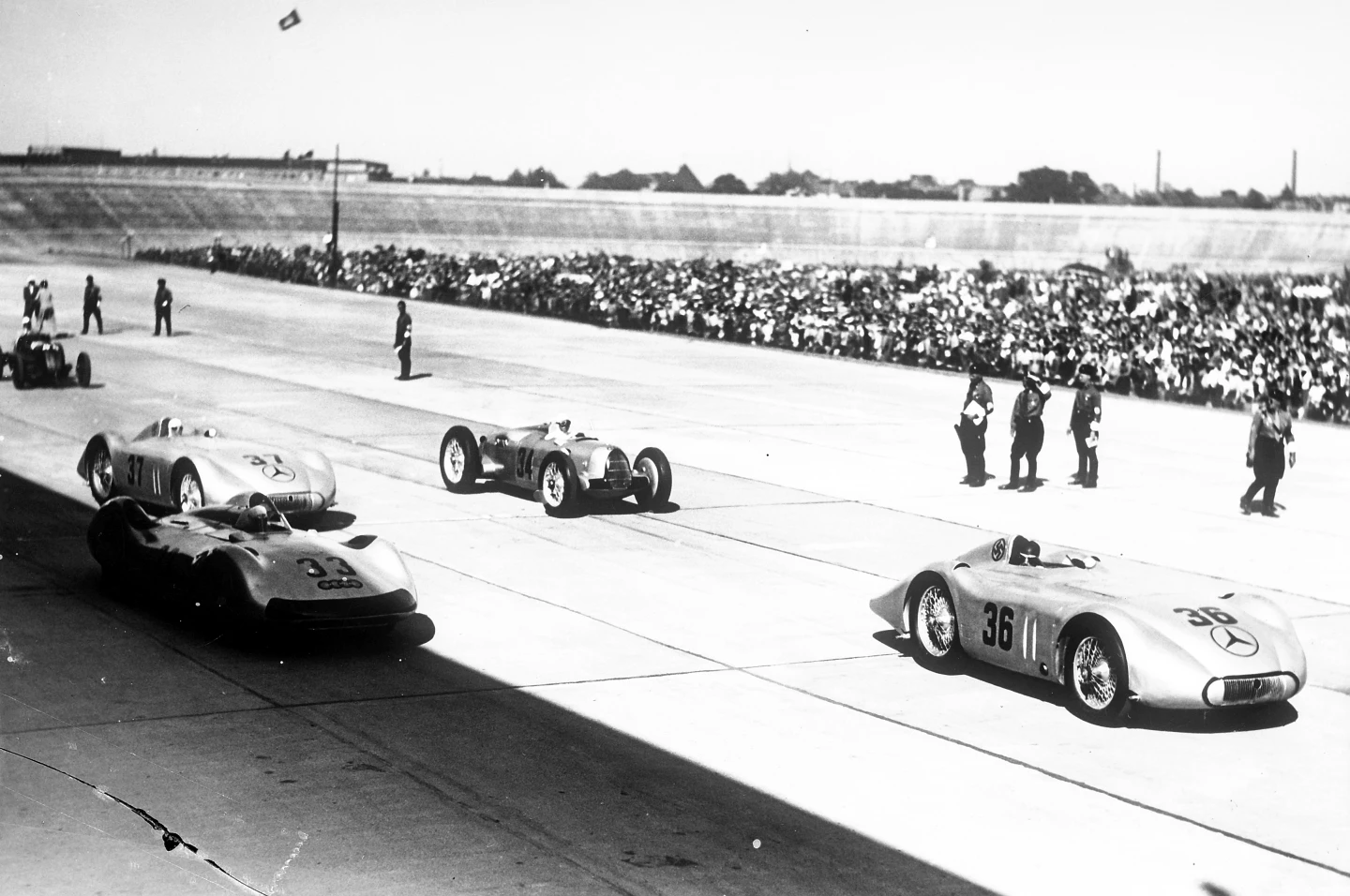
Mercedes Benz had indeed used fully-enclosed streamlined bodies on its racing cars in the pre-war period as the above image taken in 1937 clearly shows. The event pictured was held at Berlin's famous AVUS test track which saw the running of many significant German races, rarely ran to Grand Prix regulations.
Built on land put aside on the outskirts of Berlin in 1907, by the time it was completed in 1921, the circuit was in the center of the city and became the most important race to win every year for the premier German marque.
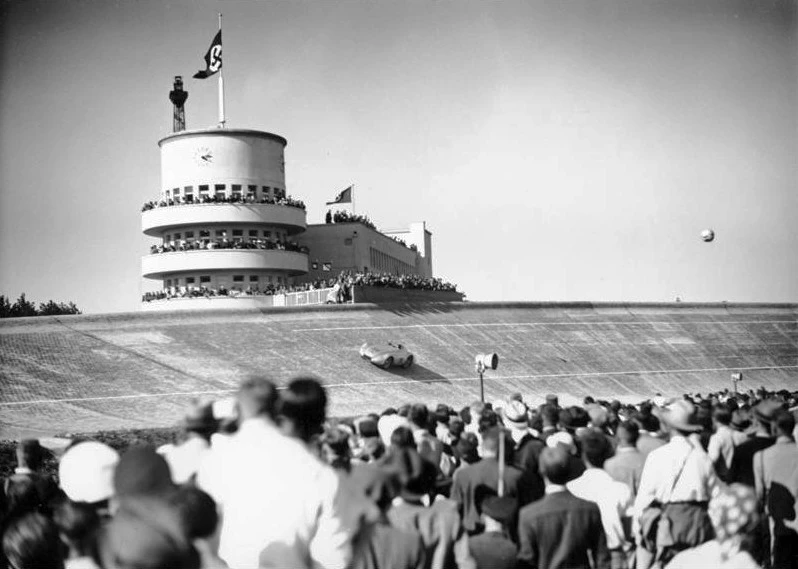
The AVUS is deserving of a Gizmag story in its own right. In 1907, Germany's booming automotive industry united with a little help from Kaiser Wilhelm to build a motor-sport venue and a test track. Sadly, by the time it was completed, after delays and WWI, was 15 years later.
One of the principal uses of the track was the high speed testing of road cars, so the race circuit was always very fast, using part of an autobahn as the two main straights with the cars lapping in the first races there in 1921 at an average of over 100 mph.
In 1937, a large banked section was added and speeds skyrocketed. Amazingly, the bank had no safety fence and if you drifted too high on the banking, you were launched tangentially into space at around 200 km/h. This astonishing video footage of the death of Jean Behra on the banking at AVUS shows a different era of motorsport safety.

Three weeks after Mercedes-Benz rocked the world with the W125 at the 1937 Tripoli Grand Prix, Mercedes took three fully-streamlined W125 12-cylinder cars to the AVUS event (pic directly above).
With three accomplished high-speed drivers in them (Caracciola, Lang and von Brauchitsch), the lap record took a fearful pounding that day, with Von Brauchitsch breaking the 160 mph average speed mark during a heat, and Hermann Lang taking victory in the final at an average speed to 162 mph with a fastest lap at 168 mph.
Clearly, when Mercedes rolled up with the streamliners at Reims in 1954, aerodynamics was a mature well-used technology that had seen many laps on the AVUS and Untertürkheim test track. Indeed, but for the Grand Prix regulations in the late thirties, Mercedes Benz would have debuted full-streamlining much earlier.
In keeping with its aerodynamic forebears, the engine of the W196R was designed to give the vehicle the lowest frontal area possible: an in-line lay-down 2496cc straight eight with the power take-off from the center of the engine’s long crankshaft to minimize vibration.
The streamlined body of the W196 was its greatest distinguishing feature, and by comparison to the mono-posto design of its competitors, it must have seemed incredibly futuristic at the time.
Silver Arrows success on the racetrack
The Mercedes-Benz W196R won nine of 12 Grands Prix it contested and is one of the most successful racing cars of all-time.

The French Grand Prix 1954
July 4, 1954 marked a special day in German history: the country's reemergence as an international sporting power. Two feats on the same day resulted in a resurgence of national pride. Germany beat Hungary 3-2 to win the FIFA World Cup of football, and Mercedes Benz rejoined F1 motor racing after a 15 year absence, sweeping the 1954 French Grand Prix in futuristic new streamlined Silver Arrows cars.

The cars that rolled out of the Mercedes truck at Reims for the French Grand Prix in 1954 stunned the F1 world before they had turned a wheel (VIDEO).

Everyone knew that Mercedes was coming with a special car, as can be seen from the promotional poster of the day (the "guess" at what it looked like is top left in the poster), in stark contrast to the Mercedes-produced poster promoting the win. In one weekend, Formula One progressed visually and technologically, around a quarter century.
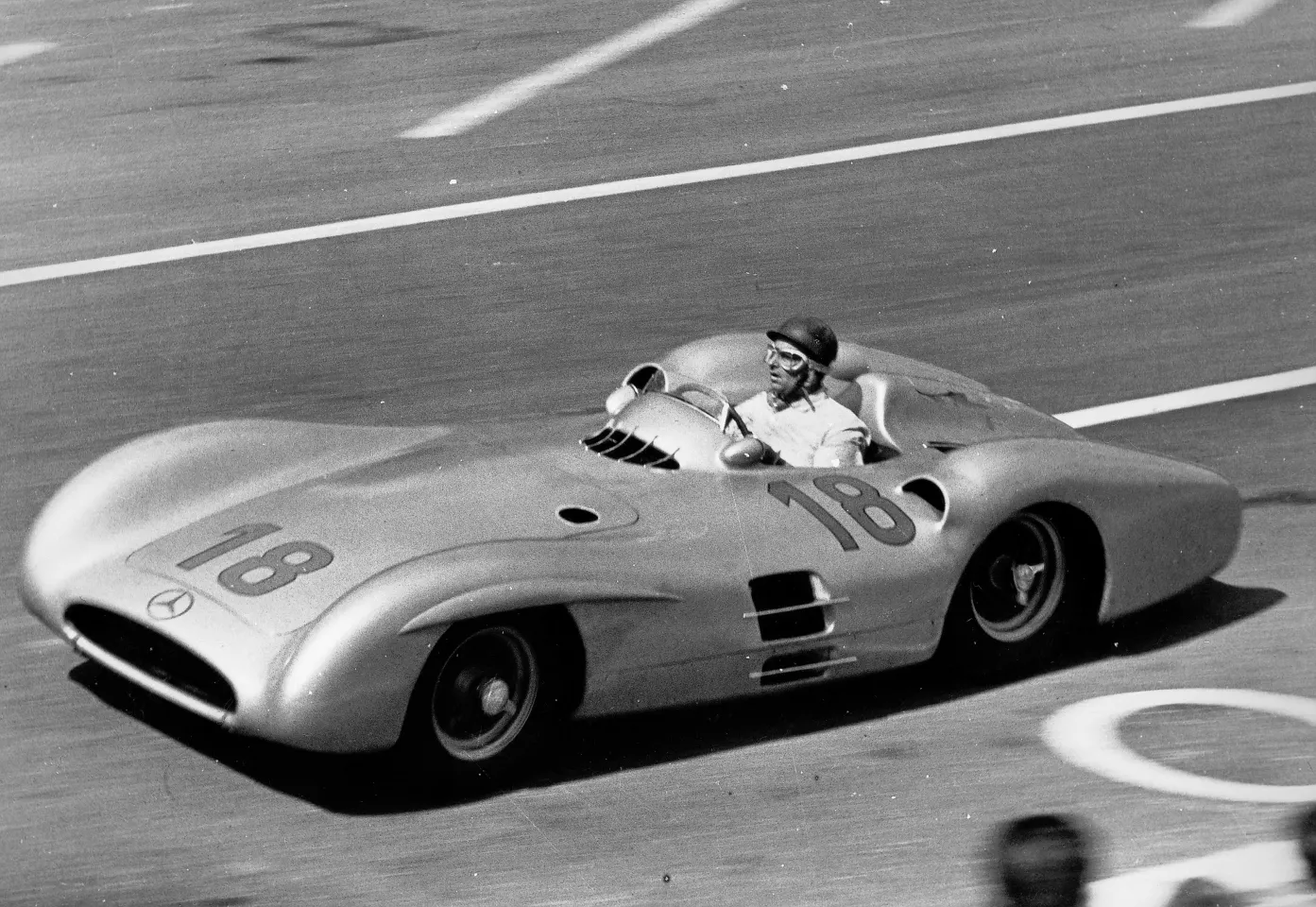
For a company desirous to reclaim a legacy of global racetrack dominance it had experienced regularly since the beginnings of motorsport, the victory at Reims in 1954 was a momentous result and Mercedes Benz became a renewed symbol of Germany's future.
The engine which powered the W196 to a dominant 1-2 in both qualifying and the race at Reims produced 189 kW for a top speed of over 300 km/h, though the engine was developed progressively to a best of 213 kW towards the end of 1955.
Coupled with its aerodynamic supremacy, this made the W196 much quicker than its competitors on the long straights of the high speed Reims circuit.

Indeed, the Mercedes of Fangio and Kling finished the French Grand Prix in nose-to-tail formation as per team orders, more than a lap ahead of the third-placed Ferrari.
In one afternoon, Mercedes Benz had announced to the world that it was BACK, and it had done so with its distinctive Silver Arrows design, a design that resonates to this day.
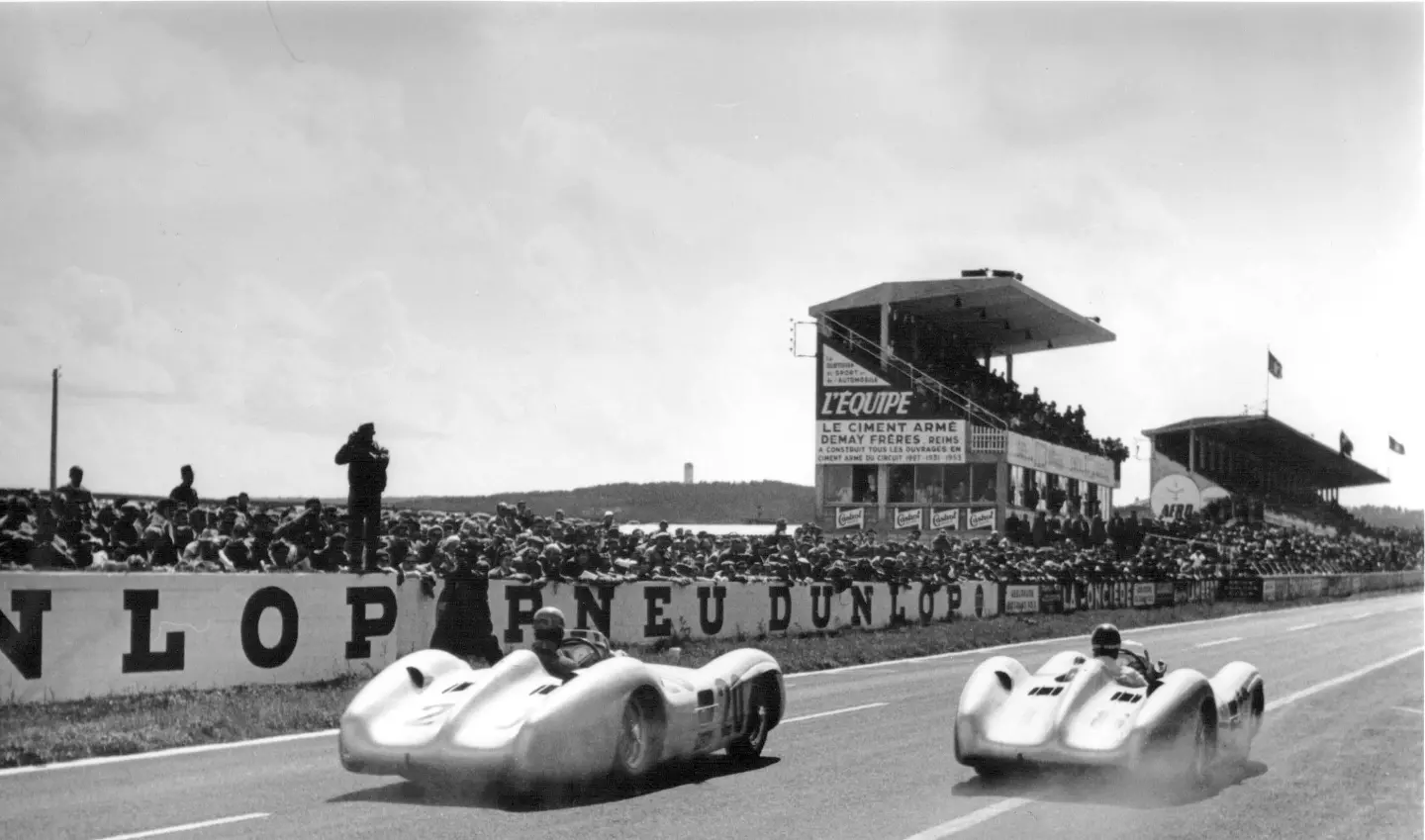
The British Grand Prix - 1954
The 1954 British Grand Prix at Silverstone was the second start for the W196R and showed the fallibility of Mercedes streamliners for the first time. On a fast circuit their aerodynamic efficiency gave them enough speed to breeze past on every straightaway, but when the circuit was twisty, the enclosed front wheel prevented precision wheel placement.On a clear track, Fangio's Mercedes was faster, but in the cut-and-thrust of racing, he did not have enough control and precise wheel placement, and several times glanced off oil-drums which marked the edge of the Silverstone circuit. The race was to be the W196R's first defeat, with Fangio quite clearly bearing damage to both sides of the streamlined fenders as he battled to fourth place in the race.
Along the way he proved the Mercedes was very fast, running the first 100 mph lap of the Silverstone circuit, but with Mercedes home Grand Prix looming next on the calendar, drastic measures were called for.
1954 German Grand Prix
The Bonham's car entered the Silver Arrows story in the German Grand Prix of 1954. It is a monoposto open wheeler version created for Fangio for the Nürburgring track after the lessons learned at Silverstone.
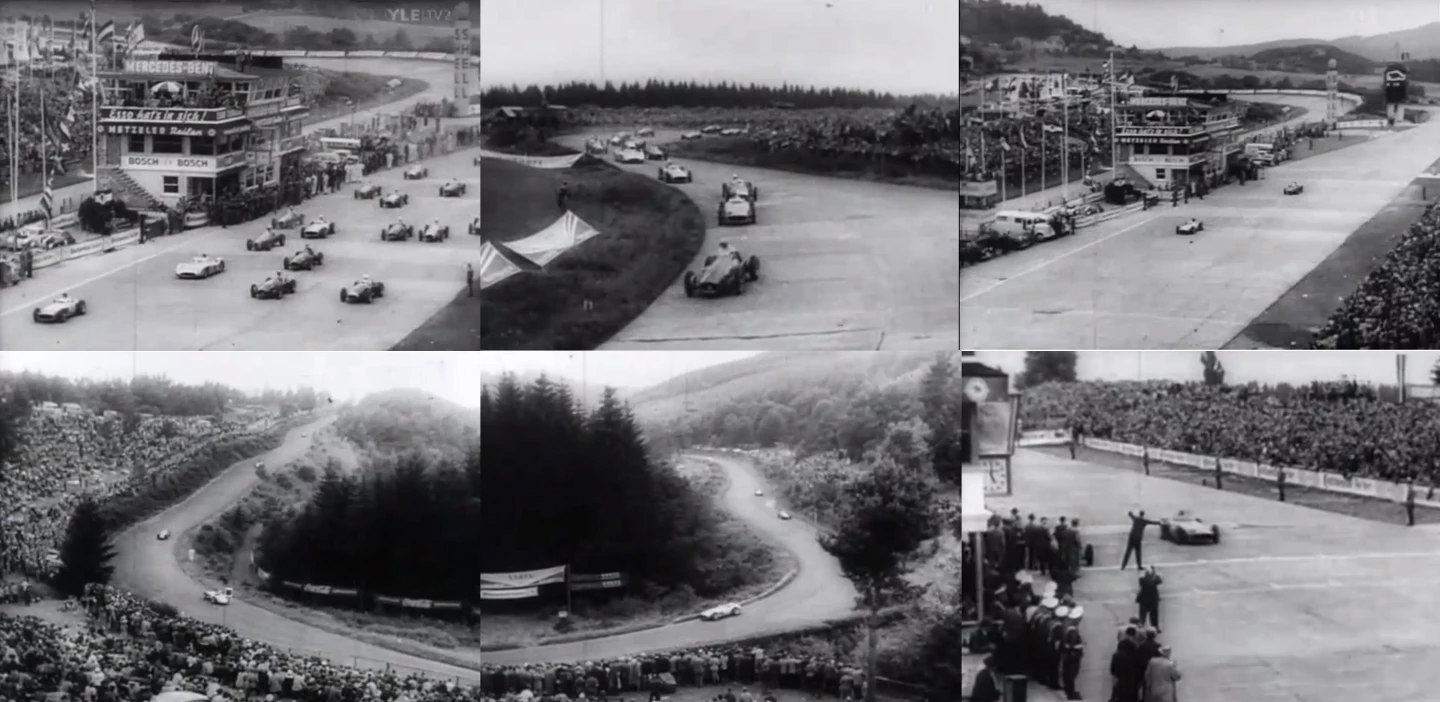
The car took pole position in its first race, and won the event in the time of three hours 45 minutes 45.8 seconds. To this date, that's the longest F1 championship race other than the Indianapolis 500 (mile) events of the fifties.
Fangio shared the front row with the Ferrari 625 of Mike Hawthorn and the Maserati 250F of Sterling Moss but as the race unfolded, it was Fangio in the lead with team-mate Karl Kling bearing down upon him after a drive through the field where he sat the lap record of 9 minutes 55.1 seconds for the 22.810 km (14.173 mile) course.
In one of the earliest examples of an F1 driver disobeying team orders, and despite some highly animated pit signals, Kling overtook Fangio. Fangio always maintained that he had Kling's measure and simply sat behind the rampaging German until he encountered rear suspension problems, then cruised to an easy victory with more than a minute and a half in hand over the Ferrari of Hawthorn.
Swiss Grand Prix 1954
The second race for the Bonhams W196R was the Swiss Grand Prix of 1954 held on the uber-frightening, tree-lined Bremgarten circuit. Although Fangio lined up on the front row, the pole position was taken in a Ferrari by José González.
In the race though, Fangio grabbed the lead into the first corner and was never headed, winning the last F1 race in Switzerland by over a minute.
This win gave him his second world drivers championship and he was to go on to win the championship again in 1955, 1956 and 1957.
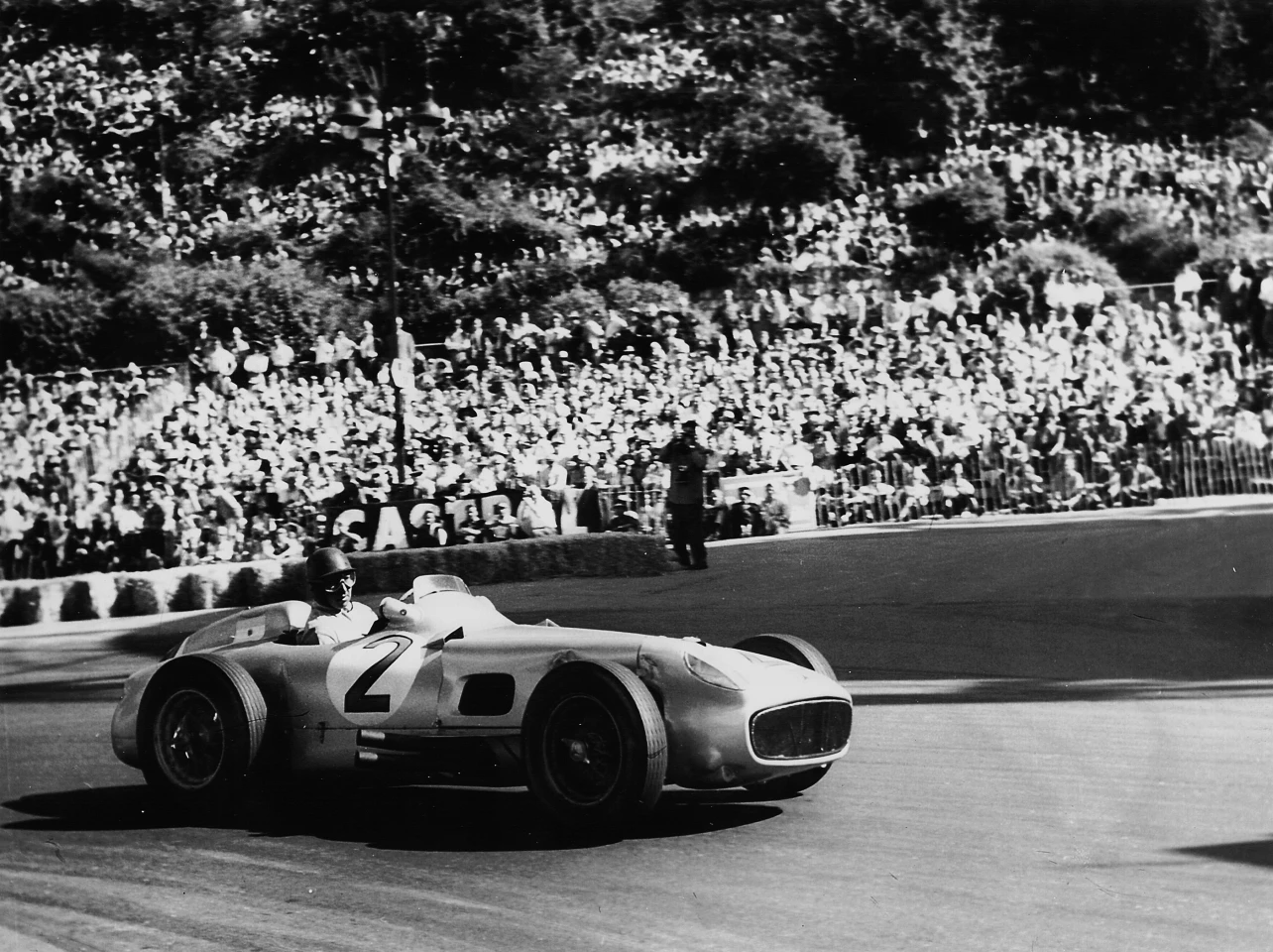
1955: Asserting dominance
In 1955, the W196R won all but one of the races it contested (Monaco Grand Prix) and the W196S won everything it contested but one race – the Le Mans 24 hour. Mercedes would certainly have won that race. The stellar pairing of Sterling Moss and Fangio was in second place and close behind the leading Jaguar D-type of Mike Hawthorn when an incident changed the world of motorsport forever.
Mercedes driver Pierre Levegh got caught up in an incident and was launched into the crowd, killing himself, and over 80 spectators. We have written before about the cavalier attitude of almost everyone towards racetrack safety and the incident caused such public outcry that motor racing was banned in some countries (notably Switzerland – the reason Fangio's 1954 win was the last Swiss GP) and racetrack safety considerably improved.
Mercedes decision to withdraw from the race in respect of Levegh was understandable, as was the subsequent decision by the brand to leave the sport. The World Sportscar Championship and the World Formula One championship had been won, and the name Mercedes Benz was firmly implanted in the brains of people across the world.
The extraordinary Juan Manuel Fangio
Widely acknowledged as the world's best driver, Argentinian Juan Manuel Fangio had signed to drive the Silver Arrows for 1954, but as the German marque's car was still under development and was not scheduled to be ready for the first three races of the season, Mercedes offered either a full race fee while he sat the race out, or to allow him something else.
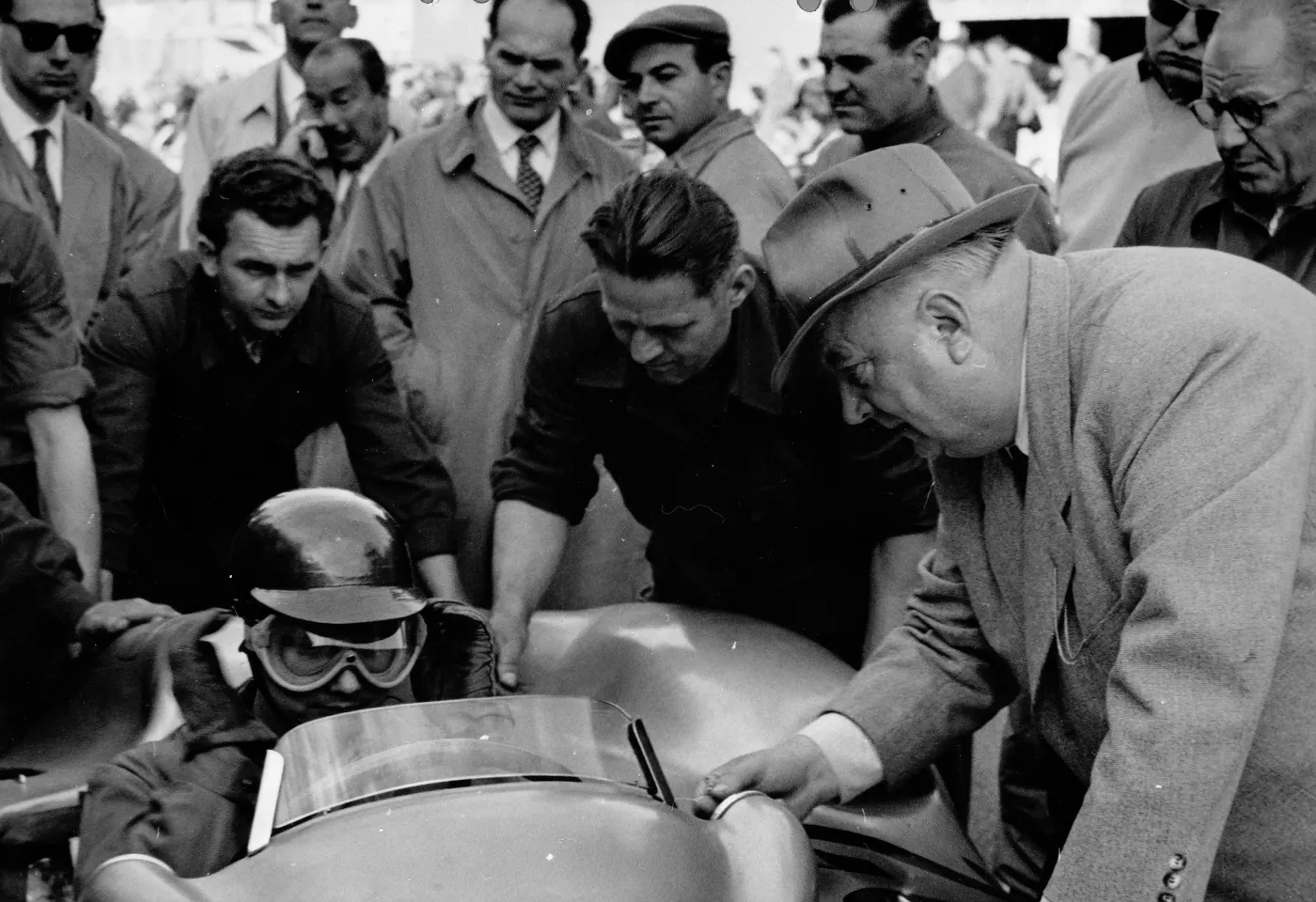
This "fair play" approach by Mercedes illustrates a time when more gentlemanly conduct was common in racing, and perhaps also reflects on Fangio's unique "situation" of being an old man in a sport increasingly moving towards the fearlessness and reflexes of youth.
Fangio's racing years were largely stolen by the war. When he drove his FIRST F1 race, Fangio was 38 years of age, yet he went on to win 24 Formula one races, five driver titles with four teams (Alfa Romeo, Ferrari, Mercedes-Benz and Maserati), and still easily retains the highest winning percentage of any driver in F1 history at 46% – 24 wins from 52 starts. For the record, those behind him are Alberto Ascari (13 from 33 / 39.4%), Jim Clark (25 from 73 / 34.25%), Michael Schumacher (91 from 308 / 29.6%), Jackie Stewart (27 from 100 / 27%), Ayrton Senna (41 from 162 or 25.3%), Alain Prost (51 from 202 / 25.2%) and as of today, Sebastian Vettel (30 from 110 / 27.3%)

Fangio began racing at an age most drivers are retired, yet he still holds the highest percentage of pole positions (29 of 52 / 55.8%), the highest percentage of front row starts (48 of 52 / 92.3%) and he was the oldest F1 World Champion in history at 46 years, 41 days in 1957. His five titles were won at 41, 43, 44, 45 and 46 years of age respectively.
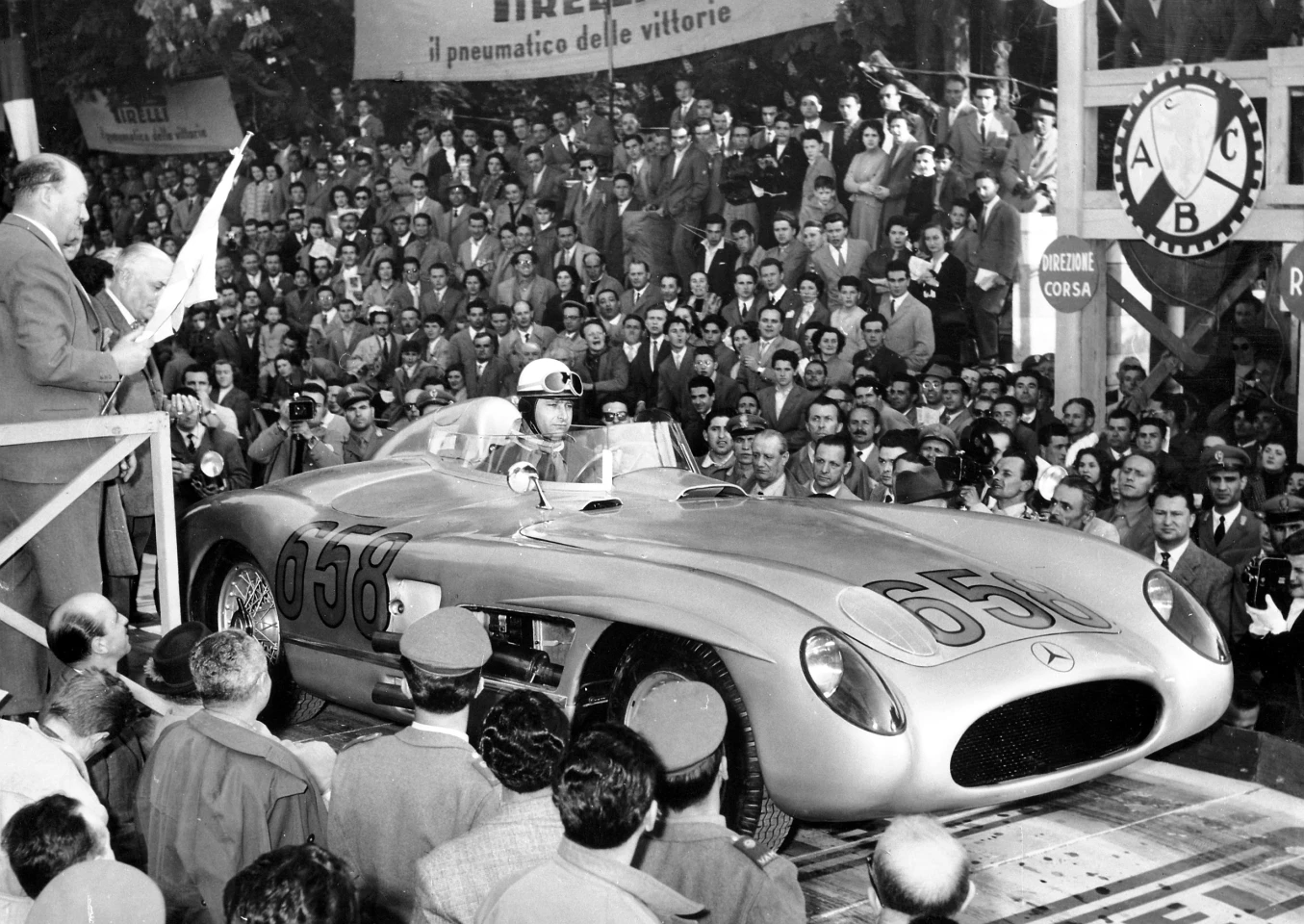
Michael Schumacher won seven world titles and 91 Grands Prix before he retired the first time at 37. He returned for another three years after three years in retirement and didn't win another race.
Four-time F1 Champ Alain Prost retired at the age of 38. The records of other long-term, three-time title winners also suggests that driving performance begins a rapid decline at around 40 years of age. Jack Brabham won his last title at 40, Jackie Stewart (36), Niki Lauda (35), Nelson Piquet (35) and Ayrton Senna (31) round out the pantheon of greats.
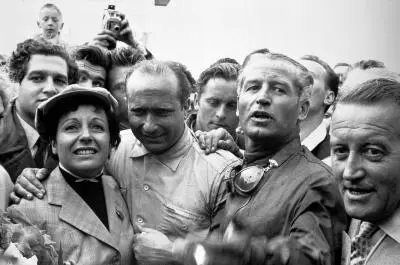
Only one of the three-time championship winning drivers is still driving. If Sebastien Vettel (just turned 26) were to keep racing and winning to the same age as Fangio did, he might be clocking up his 24th world driver's title in 2033, when he'll be 46.
Clearly, we didn't see Juan Manuel Fangio at anything like his best. He drove all but seven of his Formula One events AFTER the age of 40 years.
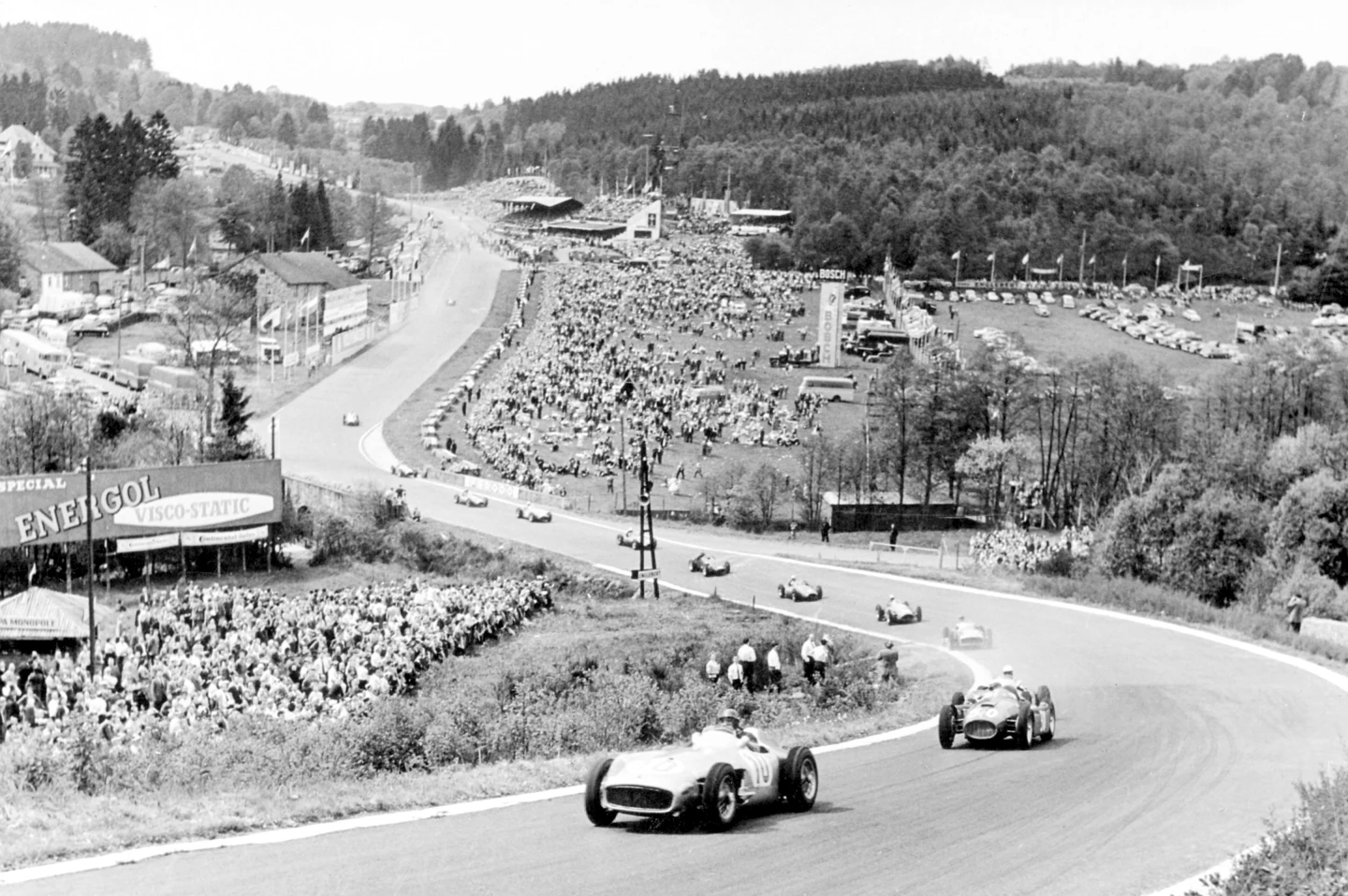
Reigning champ Fangio was 43 when he signed with Mercedes for 1954 but in the absence of the new cars for the first three races of the season, chose to drive a private Maserati 250F, in the first two Grands Prix of the season. He duly won the first two world championship races – his home Argentinian Grand Prix and the Belgian Grand Prix at Spa-Francorchamps, then missed the Indianapolis 500 round, as did every other championship contender.
A lasting legacy
The Bonhams W196R is the only available example of a milestone race car, a car that dominated every Grand Prix it contested, even the three races it didn't win. Only the 1988 McLaren Honda MP4/4 driven by the pairing of Ayrton Senna and Alain Prost (16 starts, 15 wins, 15 poles, 10 fastest laps) and the Ferrari F2002 driven by Michael Schumacher and Rubens Barrichello (19 starts, 15 wins, 11 poles,15 fastest laps) have better statistics than the Mercedes-Benz W196R. Doubtless as the automotive auction market evolves, there will be more expensive cars sold. More global wealth will mean greater demand for exquisite examples and markets tend to behave irrationally when supply approaches zero. While there may be more expensive cars sold in the future, there are few cars in history that can boast a provenance as comprehensive as this Mercedes-Benz and all the trickle-down impact it and its W196 family had on global sports car markets.
The global recognition experienced by Mercedes inspired others (notably Soichiro Honda) to build a brand based on the old adage of "win on Sunday, sell on Monday." In the case of the record-breaking W196 F1 Silver Arrow, this selling potential has lingered on for more than half a century.


















































































































